Clifford Garstang's Blog, page 122
September 6, 2011
Man Booker Prize 2011 short list announced
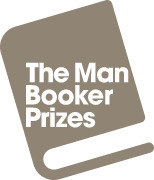 The shortlist for the 2011 Man Booker Prize is out:
The shortlist for the 2011 Man Booker Prize is out:Julian BarnesThe Sense of an EndingJonathan CapeA truly wonderful novel that will have the reader immersed in the story from the very first page, and all...read more »[image error]Carol BirchJamrach's MenagerieCanongateI was born twice. First in a wooden room that jutted out over the black water of the Thames, and...read more »[image error]Patrick deWittThe Sisters BrothersGranta BooksFrom the author of the acclaimed Ablutions, this dazzlingly original novel is a darkly funny, offbeat western about a reluctant...read more »[image error]Esi EdugyanHalf Blood BluesSerpent's Tail'Chip told us not to go out. Said, don't you boys tempt the devil. But it been one brawl of...read more »[image error]Stephen KelmanPigeon EnglishBloomsburyNewly arrived from Ghana with his mother and older sister, eleven-year-old Harrison Opoku lives on the ninth floor of a...read more »[image error]A D MillerSnowdropsAtlantic Books"A.D. Miller's Snowdrops is a riveting psychological drama that unfolds over the course of one Moscow winter, as a young...read more »
Published on September 06, 2011 05:18
Killer Titles
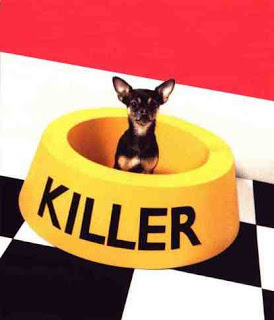 I've been thinking about book titles lately, because of the very good news that I've got a new book coming out next year from Press 53, a great small press that also published my first book, In an Uncharted Country
I've been thinking about book titles lately, because of the very good news that I've got a new book coming out next year from Press 53, a great small press that also published my first book, In an Uncharted Country . And while I've had a working title for that book for a long time, I suddenly came to doubt it, and came up with an alternative. And then another. And another.
. And while I've had a working title for that book for a long time, I suddenly came to doubt it, and came up with an alternative. And then another. And another.So I was intrigued this morning when I saw GalleyCat piece, Three Elements of a Killer Title, which links to a blogger's discussion of the subject, Three Criteria for a Killer Title. (Apparently GalleyCat didn't think Katie Ganshert's title was sufficiently "killer".)
Her three criteria/elements are:
1. It has to represent the story
2. It has to be intriguing
3. It has to sound good
Okay, I can't really quarrel with these, but I'd add a fourth element. A really killer title has to be memorable . That's what I'm looking for. So that's my 4-part test: appropriate, intriguing, euphonious, and memorable.
So, where does that lead me in my own decision making? I think I'm sticking with my working title, which has been WHAT THE ZHANG BOYS KNOW. It's a novel in stories about the Zhang family of Washington, DC. The title is striking and memorable, I think, and it certainly represents the story. It also suggests intrigue (what do they know?), and I like the rhythm of it, so to me it sounds good.
Of the 12 stories in the book, 6 have been published, and I'm now making a push to get as many of the remaining stories published as I can before the book comes out next fall. And then, be on the lookout for this book!
Published on September 06, 2011 04:59
September 5, 2011
Writers.com: Writing the Short Story--Make Your Story Great!
 There's still time to sign up for my "Writing the Short Story--Make Your Story Great!" class at Writers.com. It's a 10-week class for beginning to intermediate writers who want to develop their grasp of fiction fundamentals. We'll have lectures, writing exercises, and we'll workshop stories by all the participants. Most importantly, we'll have fun in the process! The class is scheduled to start on September 6, but we'll spend the first few days getting organized. I hope you can join us!
There's still time to sign up for my "Writing the Short Story--Make Your Story Great!" class at Writers.com. It's a 10-week class for beginning to intermediate writers who want to develop their grasp of fiction fundamentals. We'll have lectures, writing exercises, and we'll workshop stories by all the participants. Most importantly, we'll have fun in the process! The class is scheduled to start on September 6, but we'll spend the first few days getting organized. I hope you can join us!
Published on September 05, 2011 15:46
Book Review: Caged: Memoirs of a Cage-Fighting Poet by Cameron Conaway
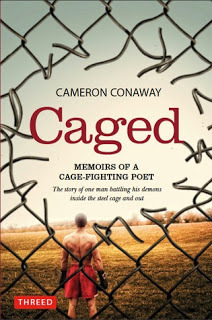
Caged: Memoirs of a Cage-Fighting Poet
Cameron Conaway
Threed Press, 2011
Cameron Conaway is a poet (a book and a chapbook forthcoming in 2012 from Salmon Poetry and Finishing Line Press) and was, for a time, a cage-fighting mixed-martial artist. He is also the sensitive son of an abusive father. And that triple-threat combination has resulted in this suspenseful, inspiring memoir that is partly a guide to health and nutrition and partly encouragement for all who might find solace in literature for the challenges that life presents.
Conaway's story is, in some ways, familiar. When he was a kid, his father, as Conaway portrays him, was an angry man--intolerant, often verbally and sometimes physically abusive. Divorce was inevitable, but that seemed to make things worse for Conaway, who was perpetually torn by his admiration for his father (an accomplished martial artist) and hatred for the way his father often treated him. Despite the mistreatment, Conaway craved his father's approval, and that craving pushed him to succeed. The family situation came to a head when Conaway tried to protect his younger sister from their father's abuse; that clash ended their relationship.
How Conaway then channels his conflicted emotions is the real story here—he turns in a big way to physical training and sports. Fond of basketball, his height keeps him from getting the playing time he desires in organized ball, and yet pick-up games on the playground provide valuable lessons about competition, adversity, and battles against opponents often much larger. Eventually he discovers martial arts—his father's discipline—but takes it a step further. Instead of the less practical versions of the sport, he would focus on real fighting: "The art of [Brazilian Jiu Jitsu] gave me the confidence that I could not only protect myself and those close to me, but gently kick the shit out of somebody if need be." This growing confidence, not surprisingly, has implications for other aspects of his life.
In college, he discovered both academic discipline—his advice here is especially worth noting—and poetry. His first poetry teacher exposed him to the practice of observation—seeing both the forest AND the trees—and he was hooked: "The way I loved [Brazilian Jiu Jitsu], I loved poetry. The goal of poetry seemed to be to show new ideas and perspectives that broadened and deepened human understanding of each other and the world."
So, while also working as many hours as he can in order to support himself, he pursues both poetry and mixed martial arts (he adds other styles to BJJ in order to have as many tools at his disposal as possible) in a big way. He participates in cage fights (traveling to Ohio, because the practice is illegal in Pennsylvania), and in the book the descriptions of these fights are as suspenseful and exciting as any I've read. He also earns a spot in a top MFA program to further develop his creative writing skills, and begins to teach in order to share his love of both MMA and poetry. Along the way, despite the commitment problems you might expect in someone from his background, he falls in love.
It's truly an inspiring story, highly readable (Conaway includes some of his own poetry that reflects both his family life and his pursuit of martial arts), and I whole-heartedly recommend it to all readers.
But that's not the only reason I wanted to write this review. Conaway has been working on this memoir for some time, and he landed a publishing contract with a major publisher in the field of martial arts. He was thrilled, as anyone would be. The book progressed through production and was scheduled for publication. And then the publisher pulled it from their list because of a threatened lawsuit—one that they knew they could win, but didn't want to spend the money to fight. After exploring his options, Conaway has gone ahead with the book—a typically gutsy move—and I'm proud to support his effort.
Published on September 05, 2011 07:33
September 1, 2011
Residency's End
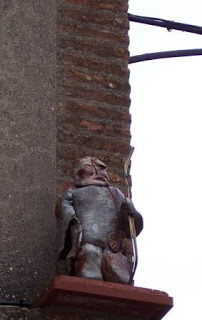 It was a brief residency, and today's the day I leave. I've got a 5:30 pm train back to Toulouse and an early flight from there (to Frankfurt, then Dulles, then Shenandoah Valley) on Friday. I'm sorry to go, but looking forward to getting home, springing the dog from the kennel, sleeping in my own bed . . .
It was a brief residency, and today's the day I leave. I've got a 5:30 pm train back to Toulouse and an early flight from there (to Frankfurt, then Dulles, then Shenandoah Valley) on Friday. I'm sorry to go, but looking forward to getting home, springing the dog from the kennel, sleeping in my own bed . . .A few nights ago, after Craig and Sandell arrived and we were up to 4 artists in the house, all trying to share a kitchen, we agreed to rotate cooking duties. My turn was last night, and I think I produced a passable eggplant/tomato/chickpea dish along with a cauliflower salad. The night before that, though, we had a "fellows' dinner"--VCCA feeds us once a week--at Le Petit Palais (check out that website if only for the pictures of the village), in Auvillar.
On the way up the hill to dinner, I spotted the little fellow at left. Cheryl explained that there is an annual Marche des Potiers in Auvillar every year and one year there was a "pilgrim" theme (see earlier post on the pilgrims of St. Jacques de Compostelle). The village then bought several ceramic figurines and installed them around town. I'd photographed several on an earlier exploratory walk, but I'd missed this one.
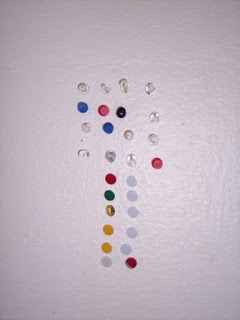 Also yesterday, besides cooking dinner for the artists, I managed to finish my book. I'm still going to be fixing a couple of things next week, and there are two scenes that I have doubts about, but otherwise it is done. I arrived at that point late yesterday afternoon, so today I've been working on other things, and packing up, including straightening my studio. Here's all that's left at this point.
Also yesterday, besides cooking dinner for the artists, I managed to finish my book. I'm still going to be fixing a couple of things next week, and there are two scenes that I have doubts about, but otherwise it is done. I arrived at that point late yesterday afternoon, so today I've been working on other things, and packing up, including straightening my studio. Here's all that's left at this point.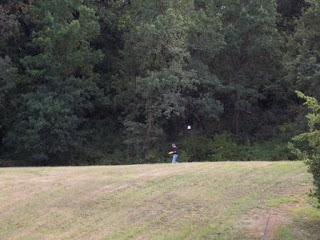 One of the things I'm missing by leaving now are some celebrations that will occur here in a couple of weeks in connection with a visit by several members of the VCCA Board, and as part of that Craig Pleasants, a sculptor and also director of Programs at VCCA, is here and he's working on an installation on the hill behind the studio building. There's Craig, picking the spot. I wish I were going to be here to see the thing come together!
One of the things I'm missing by leaving now are some celebrations that will occur here in a couple of weeks in connection with a visit by several members of the VCCA Board, and as part of that Craig Pleasants, a sculptor and also director of Programs at VCCA, is here and he's working on an installation on the hill behind the studio building. There's Craig, picking the spot. I wish I were going to be here to see the thing come together!And that's it. I'll be heading out soon. And I'll check in on the other side.
Published on September 01, 2011 04:47
August 30, 2011
Auvillar Environs - Part II
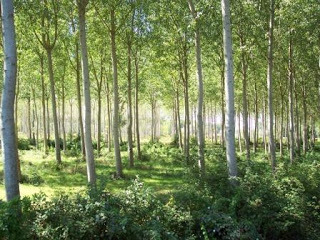 We came back from the market this morning and I got some work done, but then I realized I'm leaving in a couple of days, so if I'm going to do any more exploring, I'd best get it done. So I took the afternoon off to WALK back to Valence d'Agen. It's about 3 miles each way, and it was not, but, hey, I needed the exercise. The pedestrian friendly route is past the golf course (!) and a series of poplar groves.
We came back from the market this morning and I got some work done, but then I realized I'm leaving in a couple of days, so if I'm going to do any more exploring, I'd best get it done. So I took the afternoon off to WALK back to Valence d'Agen. It's about 3 miles each way, and it was not, but, hey, I needed the exercise. The pedestrian friendly route is past the golf course (!) and a series of poplar groves. Other than that, there isn't much to see on the walk--good for thinking and planning, though--although there is a nice shot of the power plant on the bridge crossing the cooling canal.
Other than that, there isn't much to see on the walk--good for thinking and planning, though--although there is a nice shot of the power plant on the bridge crossing the cooling canal.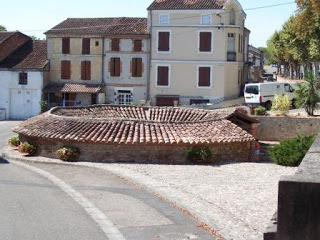 There isn't much to see in Valence d'Agen, either, although it was funny to walk around the same streets where the market was--it looks completely different. I did spot some folks playing petanque in the Place Nationale, and also walked by this old washing station--the lavoir.
There isn't much to see in Valence d'Agen, either, although it was funny to walk around the same streets where the market was--it looks completely different. I did spot some folks playing petanque in the Place Nationale, and also walked by this old washing station--the lavoir.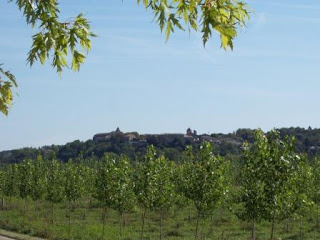 Then, on the way back, I caught these nice views of Auvillar:
Then, on the way back, I caught these nice views of Auvillar: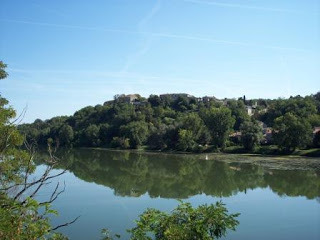
Published on August 30, 2011 09:17
Auvillar Environs
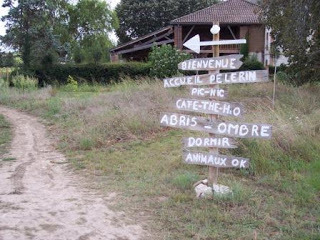 I've been here over a week now, and mostly I just work in my studio or eat/drink wine with the other fellows and the resident staff. Not too harsh. Other than the forays up the hill to the main village of Auvillar, I've taken a couple of walks. The first, on Sunday, was just across the river to the village of Espalais. There's not much going on there, but on one end of the village is a camp ground that welcomes pilgrims, because Auvillar is stop on the Pelerinage de Saint-Jacques de Compostelle. There's a steady stream of people passing right by the studio building . . .
I've been here over a week now, and mostly I just work in my studio or eat/drink wine with the other fellows and the resident staff. Not too harsh. Other than the forays up the hill to the main village of Auvillar, I've taken a couple of walks. The first, on Sunday, was just across the river to the village of Espalais. There's not much going on there, but on one end of the village is a camp ground that welcomes pilgrims, because Auvillar is stop on the Pelerinage de Saint-Jacques de Compostelle. There's a steady stream of people passing right by the studio building . . .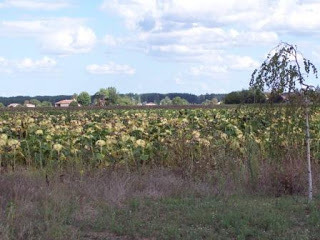 And right across the road is a sunflower field . . .
And right across the road is a sunflower field . . .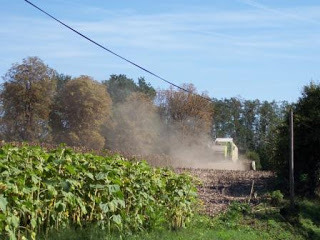 which look like this when they're being harvested.
which look like this when they're being harvested.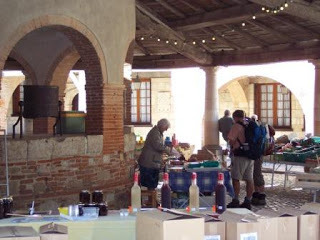 Sunday is also the morning for the Auvillar market, which is pretty tiny compared to . . .
Sunday is also the morning for the Auvillar market, which is pretty tiny compared to . . .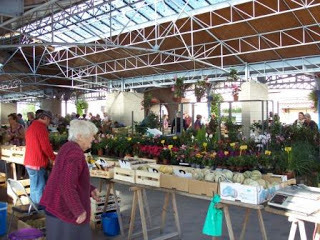 the one in Valence d'Agen, which the fellows go to on Tuesdays. We went today and I picked up some things because Wednesday will be my turn to cook.
the one in Valence d'Agen, which the fellows go to on Tuesdays. We went today and I picked up some things because Wednesday will be my turn to cook.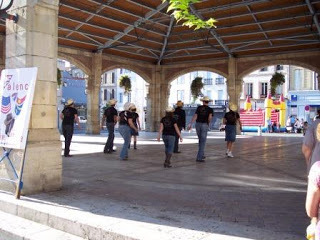 But also, while walking around the market I saw this--the Valence d'Agen line dancers! I took a short video that I'll try to upload, too.
But also, while walking around the market I saw this--the Valence d'Agen line dancers! I took a short video that I'll try to upload, too.
Published on August 30, 2011 09:07
August 25, 2011
The Village of Auvillar
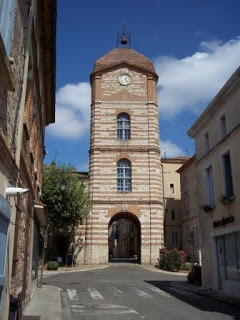 So, I'm supposed to be writing. What I'm doing, actually, is immersing myself in the novel that's already written, going through sentence by sentence, connecting some dots, filling in some blanks, you name your metaphor for the revision process. But I can only take so much of that in one sitting. So this afternoon I took a walk up the hill to the village proper. Our house and studio building actually sit in the "port" section of Auvillar, down by the Garonne River, but the town is up on a hill--fortified with walls, etc. It must have been a pretty tough little place back in the middle ages.
So, I'm supposed to be writing. What I'm doing, actually, is immersing myself in the novel that's already written, going through sentence by sentence, connecting some dots, filling in some blanks, you name your metaphor for the revision process. But I can only take so much of that in one sitting. So this afternoon I took a walk up the hill to the village proper. Our house and studio building actually sit in the "port" section of Auvillar, down by the Garonne River, but the town is up on a hill--fortified with walls, etc. It must have been a pretty tough little place back in the middle ages.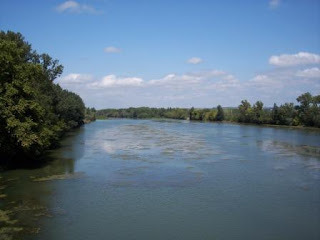 It's a beautiful village that seems pretty sleepy. There are several restaurants, but some of the shops--the bakery, the small grocer, a few others--are closed for the August vacation. It's a good thing I'm here to get work done!
It's a beautiful village that seems pretty sleepy. There are several restaurants, but some of the shops--the bakery, the small grocer, a few others--are closed for the August vacation. It's a good thing I'm here to get work done!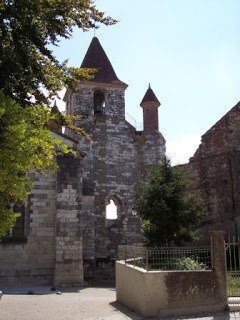 And there's a cool old church, too, as there is most everywhere you look in France, it seems.
And there's a cool old church, too, as there is most everywhere you look in France, it seems.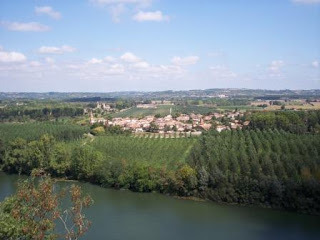 And here's a picture of the village Espalais across the river, seen from the park on the hill.
And here's a picture of the village Espalais across the river, seen from the park on the hill.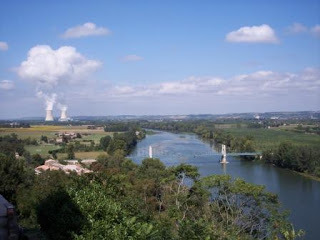 So, it's wonderfully idyllic, right? It sure seems that way, except for one little detail that I've failed to mention up to now. The plant pictured here is about 5 kilometers away.
So, it's wonderfully idyllic, right? It sure seems that way, except for one little detail that I've failed to mention up to now. The plant pictured here is about 5 kilometers away.I took lots more pictures, which I'll post on my Facebook album: Residency in Auvillar.
Published on August 25, 2011 14:21
August 24, 2011
Residency in Auvillar
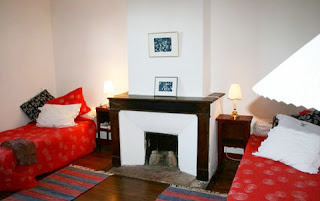 If you've been reading the blog posts lately, you know I'm in France. I arrived last Thursday, flying through Frankfurt to Toulouse, and spent a long weekend exploring the ancient city--the capital of the Visigoths!--about which I knew nothing. That was great, although the weather was very hot, but it was just a prelude to the real reason I came to Europe--my residency at VCCA France. So, on Monday morning, I trekked over to the train station in Toulouse, figured out the rail system (I'd already booked tickets but needed to deal with self-service kiosks to print them out), got on the train (very nice, even in 2nd Class), and got off in the town of Valence D'Agen, just about one hour from Toulouse. I was met there by someone from VCCA and then got settled into my room and studio. (That's a picture of my room, at left.)
If you've been reading the blog posts lately, you know I'm in France. I arrived last Thursday, flying through Frankfurt to Toulouse, and spent a long weekend exploring the ancient city--the capital of the Visigoths!--about which I knew nothing. That was great, although the weather was very hot, but it was just a prelude to the real reason I came to Europe--my residency at VCCA France. So, on Monday morning, I trekked over to the train station in Toulouse, figured out the rail system (I'd already booked tickets but needed to deal with self-service kiosks to print them out), got on the train (very nice, even in 2nd Class), and got off in the town of Valence D'Agen, just about one hour from Toulouse. I was met there by someone from VCCA and then got settled into my room and studio. (That's a picture of my room, at left.)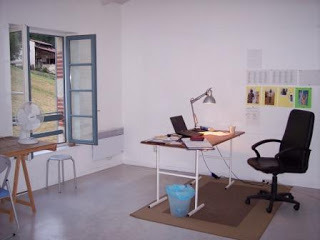 I then spent some time getting my studio set up. Since the 4 studios have to work either as visual artist's or writer's studios, they're just big empty room with tables/desks, and blank walls. Which is fine. I needed to tack some outline material on the wall, but otherwise it's pretty plain. You'll note I've got big open windows and they look out on a hillside, although the first two days I kept the shutters closed because it was too hot. It's much nicer now, so they're wide open.
I then spent some time getting my studio set up. Since the 4 studios have to work either as visual artist's or writer's studios, they're just big empty room with tables/desks, and blank walls. Which is fine. I needed to tack some outline material on the wall, but otherwise it's pretty plain. You'll note I've got big open windows and they look out on a hillside, although the first two days I kept the shutters closed because it was too hot. It's much nicer now, so they're wide open.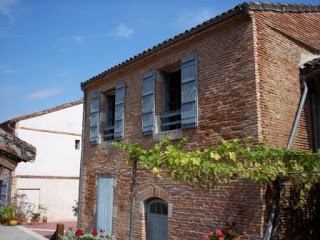 Here's what that space looks like from the outside, complete with grape arbor and patio. Those two windows on the second floor (or "first floor" in the French style) are my studio.
Here's what that space looks like from the outside, complete with grape arbor and patio. Those two windows on the second floor (or "first floor" in the French style) are my studio.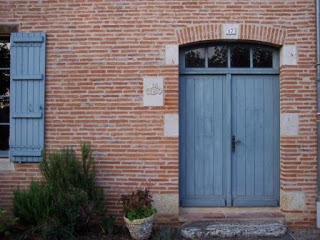 And here's a shot of the front of the studio building.
And here's a shot of the front of the studio building.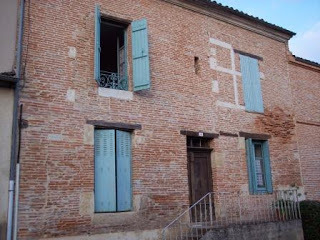 And a shot of the front of the house where we live. My room is the open window at upper left.
And a shot of the front of the house where we live. My room is the open window at upper left.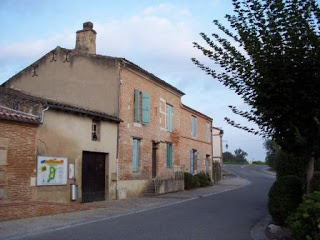 And a slightly wider angle on the house.
And a slightly wider angle on the house.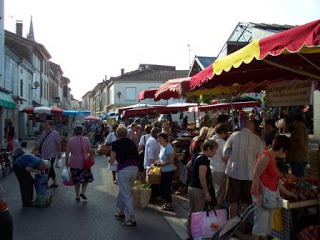 Because we cook for ourselves, it was great timing that I arrived on the day before the big weekly market in Valence D'Agen. We all went over there early to do our marketing. Lots of fun using my poor French to buy cheese, bread, eggs, yoghurt, vegetables, fruit . . .
Because we cook for ourselves, it was great timing that I arrived on the day before the big weekly market in Valence D'Agen. We all went over there early to do our marketing. Lots of fun using my poor French to buy cheese, bread, eggs, yoghurt, vegetables, fruit . . .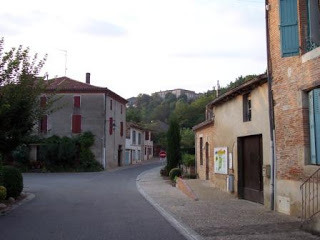 Finally, here's a shot looking up the hill at the village of Auvillar. I've made one visit up there so far, but without my camera, so I'll post some pictures of the village another day.
Finally, here's a shot looking up the hill at the village of Auvillar. I've made one visit up there so far, but without my camera, so I'll post some pictures of the village another day.Oh, yeah. The work. I've really only had one and a half days because of the marketing on Tuesday, but I got more into it today, especially because it was more comfortable, temperature-wise. I'm hoping for a good day tomorrow!
Published on August 24, 2011 12:26
August 23, 2011
The New Yorker: "El Morro" by David Means
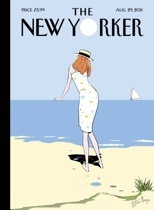
August 29, 2011: "El Morro" by David Means
I don't think I've read David Means before, or if I have I don't remember his name. After reading this story, though, I think I'll remember. And when I checked him out online I discovered that he's published four collections of stories and no novels. And then I found this terrific piece in The Paris Review: Why David Means is Not a Novelist.
In the meantime, there's this story: "El Morro". I had to look that up because I figured it was a real place, and it is. And that's not irrelevant to this story: National Park Service: El Morro.
But what makes this piece is the voice of the male character, who is in the middle of a tall tale that he's telling a girl he picked up, and he goes on and on expounding about various aspects of the Zuni, and then also about the girl, based solely on a few facts that she's given him—she was tossed out of her father's house near Springfield, Illinois. But because this is in the third person, we're actually getting her thoughts, and so she is able to fill us in on her experience since her Springfield days.
The story turns when they meet a woman who is helping guide traffic in construction over the mountain pass, and they guy becomes infatuated with her, because he assumes she is Zuni. The girl becomes less central to his thinking, until finally . . .
First, what's memorable about the story is that it is mostly about leaving your mark on the world, which is what the El Morro monument is also—ancient graffiti, in which the girl also participates. But second, the ending is memorable because it includes something of a Chekovian "spin-out"—a shift in consciousness at the end that allows it to reflect on what has gone before in a way that the story's central consciousness might not be able to.
Definitely worth the read if you have access to it.
Published on August 23, 2011 13:30



